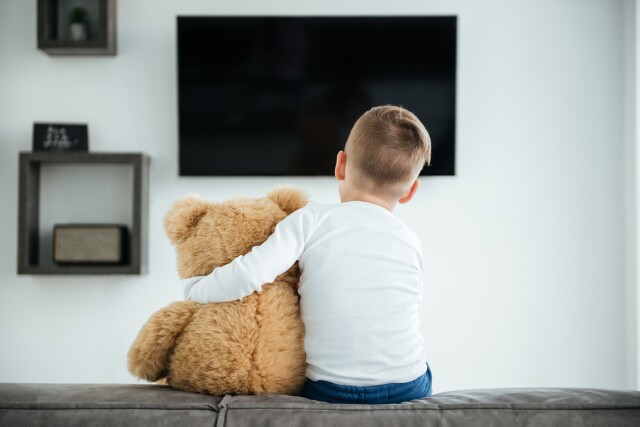Mental Health Crisis: Are Changes In the TV Landscape Contributing to the Problem?

Bill Maher delivered one of his reliably combustible editorials at the end of his weekly HBO talk program on Friday October 13, addressing what has been described as a post-pandemic mental-health crisis that is sweeping the country. "There has been a perfect storm of events in recent years that has led the surgeon general to issue an advisory that America is suffering from 'a public health crisis of loneliness, isolation and lack of connection,'" he said. He noted the usual reasons that we hear all too often these days, including the lingering impact of the prolonged COVID lockdown, the proliferation of self-checkout counters at stores that eliminate human contact, the popularity of shopping online (again, free from human interaction), watching movies at home rather than in theaters, keeping our earbuds in even when we go out, and the most dastardly devil of all, social media. ("Has anything ever been more misnamed than social media?" he asked.) Not included in Maher's list was another societal shift that appears not to be doing anyone any good at all … the "decline" of broadcast television.
I put the word "decline" in quotes because there are numerous reasons and opinions as to why the most influential medium of modern times seems to have lost its luster, along with much of its audience. It seems that those of us in the industry read or hear about the broadcast blues every day. Broadcast is a dinosaur, "they" say! ("They" have been declaring that since the '90s.) Cable is where it's "at." (Should we now say "was" given all the popularity of cord-cutting?) Streamers are the future (even if so many of them are currently crying poverty).
Having lived through the glory days of broadcast, the arrival and exciting growth of pay and basic cable and the slow start and sudden surge of streaming, here's what I know: For decades, broadcast television consistently brought people together in all kinds of ways (more on that below). Cable broke the available TV audience into more defined demographic groups but did not necessarily result in isolation. Streamers, by contrast, seem to have scattered everyone.
That's where television's role in the mental health crisis Maher described comes in.
I Love Lucy, arguably the first major television success and, when you think about it, still the biggest hit in the history of the medium, marked the 72nd anniversary of its premiere on October 15. Week after week during its first run, and undoubtedly during its summer rerun cycles, it brought people together (even if they were physically alone) for a "shared" entertainment experience that was completely new at the time. Lucy Goes to the Hospital, the episode in which the title character gives birth to Little Ricky, premiered on January 19, 1953 and remains the most-watched episode of a scripted television series ever, with more than 44 million people tuning in. (Remember, not every household had a television set at the time!)
That new communal activity continued for many decades and survives to this day (at least when sports and live entertainment events are televised).
Given the size of the broadcast audience from the '50s through the '90s, this ongoing "social" experience was punctuated by such unforgettable highlights as CBS' legendary Saturday night lineup in the '70s, NBC's formidable Must-See Thursday night lineups in the '80s and '90s, the title character's wedding on Rhoda in 1974, the resolution of the "Who Shot J.R.?" mystery in 1980 on Dallas, the series finale of M*A*S*H in 1983 and, in daytime, the courtship and wedding in 1981 of Luke and Laura on ABC's General Hospital, to name a few.
I'll add to this list the first season of ABC's Who Wants to Be a Millionaire and the first few seasons of American Idol when it was on Fox, two unscripted sensations that were so popular they jolted the entire industry.
Enjoying all these broadcast shows, and dozens (if not hundreds) more, made people of all ages feel like they were connected to something. What can we compare that to today? Outside of original content on the various channels of Hallmark Media, which reliably brings viewers (and often talent) together online to share the love, there isn't much. (It's not for nothing that Hallmark viewers are collectively and, internally at the company, lovingly known as Hallmarkies.) Thanks to the genre's popularity on Hallmark, everyone across all TV platforms wants to be in the business of making Christmas movies.
Indeed, in the pre-VCR era, when shows had to be watched while they were actually on, television gave us all something to talk about the next day. It made advertisers pretty happy, too.
The spread of cable and VCRs in the '80s and '90s chipped away at broadcast's once rock-solid foundation, but hardly broke it apart. It was, in fact, not uncommon for people to gather to watch popular broadcast shows or record them to watch with others at another time. That also applied to cable series as that medium matured.
But try doing that with a streaming show. Watching something on a streamer is largely a more singular experience than on broadcast or cable, and more to the point, there is no urgency to watch anything at any given time. The only exceptions I can think of were the early seasons of Netflix's House of Cards and Orange Is the New Black back when bingeing was something new. They were hungrily devoured in their entirety in a night or two as soon as they dropped, for fear of being exposed to spoilers on social media or, worse, being unable to "join the conversation."
To put this another way, if you watch something on a streamer today that others may not be watching, from an old episode of Suits or The Office to a new episode of The Morning Show or Poker Face, it won't be so easy to talk about it or share it tomorrow, except perhaps with a few strangers on X or Threads.
Is this new television reality as damaging to our national psyche as too much time on TikTok or shopping all alone in your room, absent human interaction? Depends on whom you ask. (If you think that doesn't matter, listen to the viewers who call in to passionately talk to hosts on QVC or HSN. They aren't really saying much, but it is clear that many don't want the calls to end, sometimes even telling deeply personal stories to their favorite personalities.)
At a time when (as Bill Maher said) we all need each other -- and when kids in particular seem to be suffering the most -- I find myself thinking about the social element that television entertainment used to provide. (I also think about the invaluable connection and influence fostered by local radio and newspapers that has been largely obliterated by modern media, but that's another column for another time.) I remember with great fondness the twice-weekly Batman viewing parties at my neighbors' house when all the kids on the street gathered to watch it on the only color television in the neighborhood, watching more sitcoms and Mets games than I can remember with my family, my dorm room frequently filling up with my floormates because I had one of the few TVs in the building and those great Friday night Dallas pizza parties with friends.
The world was a multi-layered mess then, too. But we weren't alone, unless we wanted to be.
Posted at MediaVillage through the Thought Leadership self-publishing platform.
Click the social buttons above or below to share this content with your friends and colleagues.
The opinions and points of view expressed in this content are exclusively the views of the author and/or subject(s) and do not necessarily represent the views of MediaVillage.org/MyersBizNet, Inc. management or associated writers.


